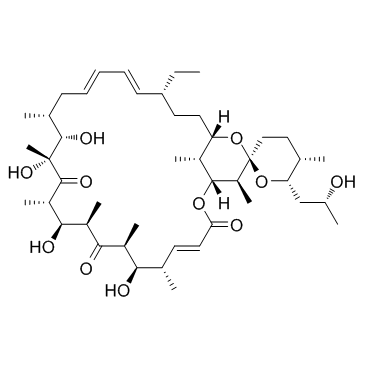579-13-5
| Name | Oligomycin A |
|---|---|
| Synonyms |
(1R,4E,5'S,6S,6'S,7R,8S,10R,11R,12S,14R,15S,16R,18E,20E,22R,25S,27R,28S,29R)-22-ethyl-7,11,14,15-tetrahydroxy-6'-[(2R)-2-hydroxypropyl]-5',6,8,10,12,14,16,28,29-nonaMethyl-3',4',5',6'-tetrahydro-3H,9H,13H-spiro[2,26-dioxabicyclo[23.3.1]nonaco
(1R,4E,5'S,6S,6'S,7R,8S,10R,11R,12S,14R,15S,16R,18E,20E,22R,25S,27R,28S,29R)-22-ethyl-7,11,14,15-tetrahydroxy-6'-[(2R)-2-hydroxypropyl]-5',6,8,10,12,14,16,28,29-nonamethyl-3',4',5',6'-tetrahydro-3H,9H,13H-spiro[2,26-dioxabicyclo[23.3.1]nonacosa-4,18,20-triene-27,2'-pyran]-3,9,13-trione Oligomycin A (1S,4E,5'R,6R,6'R,7S,8R,10S,11S,12R,14S,15R,16S,18E,20E,22S,25R,27S,28R,29S)-22-Ethyl-7,11,14,15-tetrahydroxy-6'-[(2S)-2-hydroxypropyl]-5',6,8,10,12,14,16,28,29-nonamethyl-3',4',5',6'-tetrahydro-3H,9H,13H-spiro[2,26-dioxabicyclo[23.3.1]nonacosa-4,18,20-triene-27,2'-pyran]-3,9,13-trione Spiro[2,26-dioxabicyclo[23.3.1]nonacosa-4,18,20-triene-27,2'-[2H]pyran]-3,9,13-trione, 22-ethyl-3',4',5',6'-tetrahydro-7,11,14,15-tetrahydroxy-6'-[(2S)-2-hydroxypropyl]-5',6,8,10,12,14,16,28,29-nonamethyl-, (1S,4E,5'R,6R,6'R,7S,8R,10S,11S,12R,14S,15R,16S,18E,20E,22S,25R,27S,28R,29S)- MCH 32 MFCD00065705 OLIGOMYCIN,STREPTOMYCES DIASTATOCHROMOGENES EINECS 209-473-3 OLIGOMYCIN A,STREPTOMYCES DIASTATOCHROMOGENES |
| Description | Oligomycin A, created by Streptomyces, acts as a mitochondrial F0F1-ATPase inhibitor, with a Ki of 1 μM; Oligomycin A shows anti-fungal activity. |
|---|---|
| Related Catalog | |
| Target |
Ki: 1 μM (F0F1-ATPase)[1] |
| In Vitro | Oligomycin A is a mitochondrial F0F1-ATPase inhibitor with a Ki of 1 μM. Oligomycin A shows cytotoxic to the NCI-60 cell lines, with GI50 of 10 nM. Oligomycin A also inhibits the activity of Triton X-100-solubilized ATPase with a Ki of 0.1 μM. Furthermore, Oligomycin A has anti-fungal activity[1]. Oligomycin A (2.4 µM) inhibits the ability of spermatozoa to achieve feasible in vitro capacitation (IVC), and also suppresses progesterone-induced in vitro acrosome exocytosis (IVAE) as well as the concomitant peaks of O2 consumption and ATP levels[2]. |
| Cell Assay | Drug (Oligomycin A, etc.) dilutions are added to monolayer or suspension cells in 96 well plates in triplicate for varying times. MTT is then added to the wells at a final concentration of 0.5 mg/mL. Supernatant is removed after pelleting the reduced MTT crystals. The crystals are fully dissolved in 40 mM HCl in isopropanol. Plates are scanned on a microplate reader at 595 nm[1]. |
| References |
| Density | 1.1±0.1 g/cm3 |
|---|---|
| Boiling Point | 886.3±65.0 °C at 760 mmHg |
| Melting Point | 150-151ºC |
| Molecular Formula | C45H74O11 |
| Molecular Weight | 791.063 |
| Flash Point | 252.0±27.8 °C |
| Exact Mass | 790.523132 |
| PSA | 180.05000 |
| LogP | 6.17 |
| Appearance | white to off-white |
| Vapour Pressure | 0.0±0.6 mmHg at 25°C |
| Index of Refraction | 1.543 |
| Storage condition | −20°C |
| Water Solubility | Soluble in DMSO, ethanol or acetone |
CHEMICAL IDENTIFICATION
HEALTH HAZARD DATAACUTE TOXICITY DATA
|
| Symbol |

GHS07 |
|---|---|
| Signal Word | Warning |
| Hazard Statements | H302 |
| Personal Protective Equipment | dust mask type N95 (US);Eyeshields;Gloves |
| Hazard Codes | Xn,T |
| Risk Phrases | 22-68/20/21/22-20/21/22 |
| Safety Phrases | 36/37 |
| RIDADR | UN 2811 |
| WGK Germany | 3 |
| RTECS | RK3325000 |
| Packaging Group | III |
| Hazard Class | 6.1(b) |
| HS Code | 29419090 |


